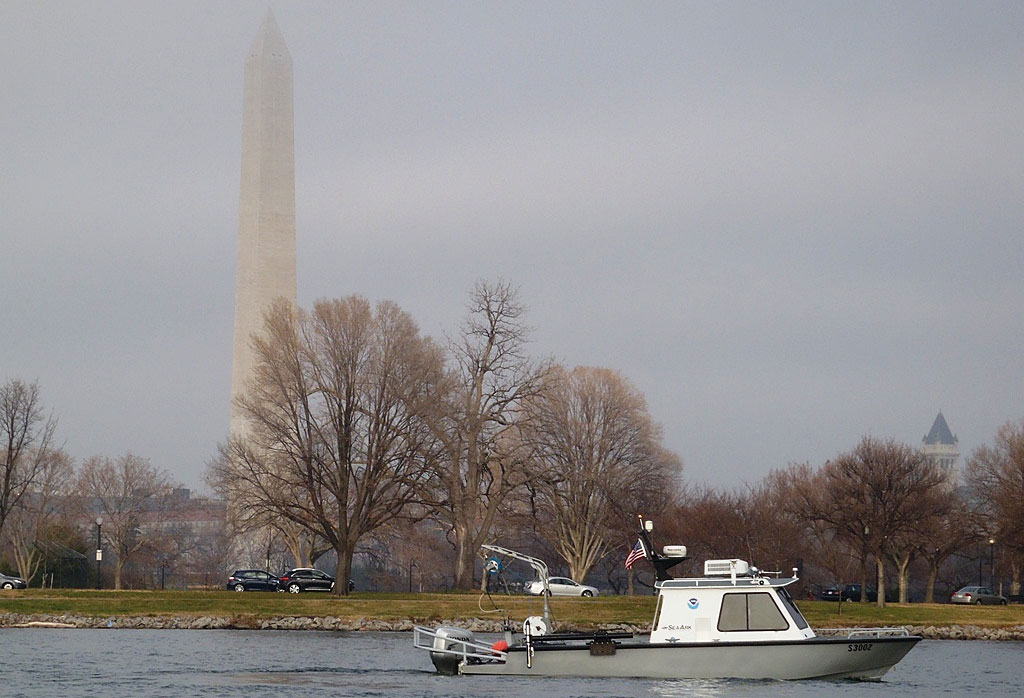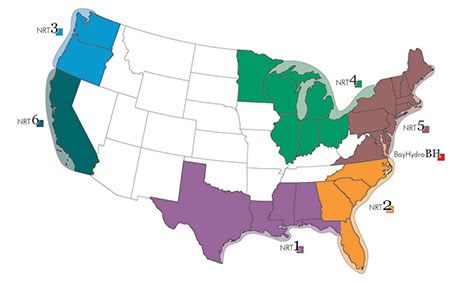2016 Coast Survey Navigation Response Team Schedule
Planned nautical chart updates are based on requests from mariners around the nation.

A Monumental Task
Navigation response teams survey for chart updates, emergency response, and homeland security. Here, a NRT vessel surveys the Potomac River Tidal Basin near the Washington Monument.
Coast Survey's navigation response teams (NRTs) play a key role in the nation's maritime emergency readiness, scanning the seafloor with sonar systems to locate underwater hazards to navigation. In between deployments for maritime emergencies, NRTs collect hydrographic data for updating nautical charts. The following are projects slated for 2016 in response to requests from mariners around the country:
- NEW YORK: Beginning in June and throughout the summer, NRT5 will survey the Hudson River, with a focus on the area from Albany to Kingston. This is a continuation of the project started at the request of the Hudson River Pilots (as reported in NOAA plans multiyear project to update Hudson River charts). Coast Survey research vessel Bay Hydro II is slated to join the NRT for most of the summer to get as much new charting data as possible. In October, NRT5 will move to Eastern Long Island Sound to finish up some shallow survey work adjacent to recent NOAA Ship Thomas Jefferson's extensive survey project.
- GEORGIA: In March, NRT2 begins a 16-month survey project in Saint Andrew Sound. The area, which has significant traffic from small boats, tugs, and barges, is reportedly experiencing small boat groundings, and Coast Survey's navigation manager in the area has received several requests for a modern survey. Coast Survey will use the data to update NOAA chart 11504 and ENC US5GA12M, as well as other charts covering portions of the specific surveyed areas. The existing charted soundings are from partial bottom coverage surveys dating back to the early 1900s.
- EASTERN GULF OF MEXICO – BILOXI AND MOBILE: NRT1 will spend March and April acquiring data off the coast of Biloxi, Mississippi, to update the Intracoastal Waterway chart 11372 The team will then move to Alabama for some long-overdue "chart cleanup" work at the northern end of the Mobile Ship Channel, outside of the area controlled by the Army Corps of Engineers. The Mobile project will investigate charted items, verify reported depths, and update older NOAA bathymetry (vintage 1961) that is depicted in the inset area of NOAA chart 11376. Since the Mobile survey probably will not take the entire rest of the season, depending on interruptions for hurricane response, we are assessing additional survey needs in the area.
- WEST GULF OF MEXICO – TEXAS: NRT4 will spend all of 2016 surveying in Galveston Bay, including the bay entrance and newly charted barge channels along the Houston Ship Channel. The team is working with Coast Survey's navigation manager for Texas to identify additional charted features that require investigation to reduce localized chart clutter and improve chart adequacy.
- NORTHERN CALIFORNIA: NRT6 is slated to survey the Suisun Bay anchorage used by MARAD's National Defense Reserve Fleet, to acquire updated depths. Afterwards, NRT6 will move throughout the bay area to address charting concerns reported by the San Francisco Bar Pilot Association near Pittsburg, Antioch, San Joaquin River, and Redwood City. Coast Survey will use the data to generally update NOAA chart 18652 and ENC US5CA43M, as well as larger scale charts of the specific surveyed areas.
- PACIFIC NORTHWEST: It has been a while since Coast Survey has had an operational NRT presence for Oregon and Washington, but this is the year that NRT3 restarts survey operations in the region. The team is working with the Coast Survey navigation manager to develop survey priorities for this summer and fall.
Charting the data
Once the navigation response teams process and submit the data acquired during the surveys, the information is further processed in Coast Survey's Atlantic and Pacific hydrographic branches, and then submitted to NOAA cartographers for application to the charts. The turnaround time for updating the chart depends on the update calendars for each regional cartographic branch. If the NRTs find any dangers to navigation, the information will be relayed to mariners through the Local Notice to Mariners postings and will be applied to NOAA's electronic navigational charts (NOAA ENC®), online products, and print-on-demand paper charts. Critical updates will be applied to charts more quickly than normal depth adjustments.
Search Our Posts
Did you know?

Coast Survey strategically places six navigation response teams (NRT1-NRT6) around the country. While 80 percent of their time is spent acquiring data for chart updates, they must also maintain a state of readiness for rapid mobilization for response after emergencies.
